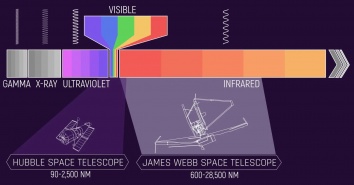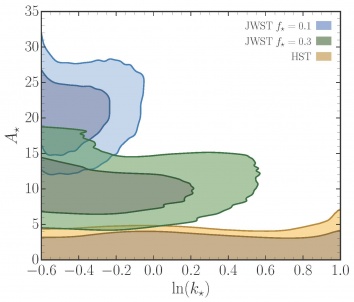
Infrared view of the Universe captured by the James Webb Space Telescope. Image credit: NASA, ESA, CSA, and STScI.
9 February 2024
Ever since the James Webb Space Telescope (JWST) captured its first glimpse of the early Universe, astronomers have been taken aback by the presence of what appear to be more “ultra-massive” galaxies than expected. Based on the most widely accepted cosmological model, they shouldn’t have been able to evolve until much later in the history of the Universe, spurring claims that the model needs to be changed.
This would upend decades of established science.
“The development of objects in the Universe is hierarchical. You start small and get bigger and bigger,” said Julian Muñoz assistant professor of astronomy at The University of Texas at Austin and co-author on a recent paper that tests changes to the cosmological model. “JWST is observing galaxies that are comparable to our own, but very early. That’s a challenge.”
Muñoz and a team of astronomers at Johns Hopkins University concluded that revising the standard cosmological model isn’t necessary. However, to account for the overabundance of ultra-massive galaxies, astronomers may have to revisit what they understand about how the first galaxies formed and evolved.
Their findings were published today in Physics Review Letters.
New Telescopes Lead to New Insights
Cosmology studies the origin, evolution, and structure of our Universe, from the Big Bang to the present day. The most widely accepted model of cosmology is called the Lambda Cold Dark Matter (ΛCDM) model or the “standard cosmological model.” While it is very well-informed, much about the early Universe has remained theoretical because astronomers could not observe it completely, if even at all.
Launched in 1990, the Hubble Space Telescope was pivotal in developing and refining the standard cosmological model. It observes the Universe in ultraviolet, visible, and some near-infrared wavelengths of light. However, this makes it better at seeing some things than others. For example, Hubble is well equipped to view smaller galaxies, which often contain higher populations of young, ultraviolet-emitting stars and less dust, which tends to absorb shorter wavelengths.
Launched in late 2021, JWST provides an important complement to Hubble’s capabilities. By observing in the near- and mid-infrared wavelengths, not only is JWST able to see farther than any other telescope, it is also able to detect objects that are invisible to Hubble.
“We’re opening a window to the unknown,” said Muñoz. “We are now able to test our theories about the Universe where we haven’t been able to before. And hopefully one day soon we’ll have the same insight on this period that we do on others.”
Testing Changes to the Standard Cosmological Model
Shortly after the Big Bang, things weren’t perfectly uniform. Tiny variations in the density of energy and matter had a momentous impact on the future structure and evolution of the Universe. Regions with greater density attracted more matter due to gravity, eventually leading to the formation of bigger and bigger structures.
To become so big so quickly, the ultra-massive galaxies observed by JWST would, in theory, only be possible if more of these higher-density regions had developed right after the Big Bang. This would require changing the standard cosmological model.
Muñoz and his team tested this hypothesis.
They picked a range of cosmic time for which both JWST and Hubble observations are available. This corresponded to roughly 500-800 million years after the Big Bang. Within this range, they identified the most massive galaxies available in the JWST data and calculated the minimum and maximum amount of change to the early density of the Universe that would be needed for them to form.
They also calculated how many smaller galaxies would result from this hypothetical change. “The fluctuation that would make more ultra-massive galaxies would, in theory, create more of the smaller ones, too,” explained Muñoz. “But that’s not what we see.” When reviewing the number of galaxies observed by Hubble in the same time range, it did not align with the team’s calculations. “We showed that you cannot change cosmology enough to explain this abundance problem, given that Hubble’s observations would also be affected.”
So why is JWST finding so many ultra-massive galaxies? One possibility is that they contain supermassive black holes. These black holes would heat up nearby gas, making the galaxies appear brighter and therefore more massive than they really are. Or the galaxies may not actually be in the early Universe at all, but look like they are because dust is causing their color to look redder than it would otherwise. Light stretches out and becomes redder as it travels through space, so this shift would make the galaxies appear farther away than they are.
In short, more research is needed. “We’re observing something new,” said Muñoz. “New machine. New regions. Exciting things happen!”
Acknowledgements
Study authors are Nashwan Sabti at Johns Hopkins University, Julian Muñoz at The University of Texas at Austin, and Marc Kamionkowski at Johns Hopkins University. Research was made possible with funding from the Horizon Fellowship from Johns Hopkins University, the UT Austin Department of Astronomy Board of Visitors, the National Science Foundation, and the Simons Foundation.
Media Contact
Emily Howard
Communications Manager
McDonald Observatory
512-475-6763
news@mcdonaldobservatory.org

Infrared view of the Universe captured by the James Webb Space Telescope. Image credit: NASA, ESA, CSA, and STScI.

By observing different parts of the electromagnetic spectrum, the Hubble Space Telescope and James Webb Space Telescope are able to see different things in the same parts of the Universe. Image credit: NASA, J. Olmsted (STScI).

Figure plotting the upper (blue) and lower (green) numbers of smaller galaxies that would form under the same circumstances that account for the ultra-massive galaxies observed by JWST. In yellow are the actual number of smaller galaxies observed by the Hubble Space Telescope. According to Muñoz and team, not enough overlap is seen with the Hubble data to support changing the standard cosmological model. Image credit: N. Sabti, JHU; J. Muñoz, UT Austin; M. Kamionkowski, JHU in a February 9, 2024, paper published in Physics Review Letters.